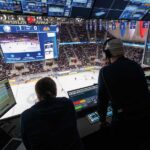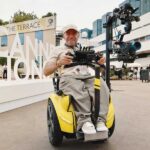Going for Gold

Posted on Oct 17, 2024 by FEED Staff
Panasonic helped bring this year’s Olympics to life. FEED looks inside La Défense Arena to see how it managed – and with what equipment
Sponsored editorial
Every four years, more than 200 countries put their best athletes forward to compete for gold on a global stage. With a modern history that dates back to 1896 – and a much more ancient history too – the Olympic Games are the foremost global sporting event, now widely televised and streamed for the whole world to watch.
To capture an event of such scope, the Olympics selected Panasonic as a Worldwide Partner in the audio/TV/video equipment category. At the 2024 Summer Olympics – also known as Paris 2024 – the company created a full technological ecosystem to suit each venue’s distinct needs. Central to this endeavour was the La Défense Arena – the largest indoor sporting venue in Europe – which hosted two of the most popular competitions: swimming and water polo.
Larger than life
To create an unforgettable atmosphere in La Défense, Panasonic employed 40 PT-RQ35K High-Brightness Projectors to illuminate the pool’s surface with Olympics-related imagery. “Unlike any of the other venues here in Paris,” begins John Ryder, Paris 2024 project manager at Panasonic, “the projection is the main source of visual imagery for the spectators.”
To prepare for the 2024 Summer Olympics, Ryder visited Paris three years ago, putting together an ‘AV feasibility study’ after surveying the various Olympic venues. “It’s not just understanding what they wanted to achieve, it’s understanding all the other elements that go together to make an Olympics. It’s absolutely essential that whatever we install works on the day – it’s the Olympic Games,” he stresses, “so it has to work.”
Panasonic’s work across the Olympics involved more than just the PT-RQ35K projectors; it required an entire system, including rigging, a Remotely Managed Service and Kairos, Panasonic’s IT/IP platform.
Mike Chesterton, AV contractor for Panasonic at Paris 2024, says it was ‘one of the first times’ that he and his team had projected onto a swimming pool. While it may seem straightforward, this presented a unique challenge since he had to wrestle with light refraction. “The light is bending as it hits the water,” he describes. When rigging the 40 Panasonic projectors – which are some of the world’s smallest and lightest – they allowed him flexibility and power as well as compactness, making all processes much simpler.
In another Paris 2024 first, Panasonic deployed its Remotely Managed Service in order to control and monitor the projectors. “I trust my equipment and my technicians,” claims Tetsuro Mizushima, project manager on Panasonic’s Remotely Managed Service. “This is a very exciting venue – and I think the spectators enjoyed our projection mappings.”
The Kairos IT/IP platform is the glue that held it all together. “Kairos is just very flexible – that’s the key thing for us here,” states Chesterton. A video processor which ingests camera feeds, audio signals and lighting, “it allows us to use multiple pictures – we pixel map all over all of our outputs and all of the LED screens.” Kairos is also capable of composing content for broadcasts and live streams.
Kairos delivered video content at almost all competition venues (26 in total), simplifying workflows and streamlining operations. Its scalability enables production of content for up to three venues via a single Kairos Core Server – with control via multiple control surfaces remotely, reducing hardware and installation cost by 66% compared to conventional operation.
“We applied digital logos in some venues as well, using Kairos, so it was easy to then have multiple control surfaces on other venues. It allowed us to have a central area where we can control everything from, effectively,” Chesterton says of Kairos, concluding that the platform was integral to Panasonic’s role in Paris 2024.
The whole nine yards
Elsewhere, Panasonic installed many more pieces of equipment – “pan-tilt-zoom cameras, studio cameras, ENG camcorders and more,” according to Andre Meterian, Paris 2024 manager for Panasonic. “The whole range of Panasonic products were in use in the venues.”
The Paris 2024 Games, now over, were in the works since at least 2018. This is when Meterian was appointed as manager; and he – on behalf of Panasonic – had three main goals in mind: “How to reduce the carbon footprint, how to make it more efficient over IP networks and how to achieve the best possible quality at the most affordable cost.”
For the first time at an Olympics, much of Panasonic’s equipment was connected over IP – a decision which signals the company’s (as well as the industry’s) increasingly wide adoption of software-based technology to replace dedicated hardware. This in turn better enables the more sustainable remote production, with a complete ecosystem of system integrators and rental companies ‘able to run the Games on behalf of Panasonic’, according to Meterian.
Making history
Following a long-standing tradition of supporting both the Olympics (since 1987) and the Paralympics (since 2014), Panasonic helped bring Paris 2024 to life, both for fans attending in person and for spectators watching from afar. The company captured the action as the USA took home eight gold medals (28 medals total) in swimming, with Katie Ledecky becoming the most decorated female swimmer in Olympic Games history. The Australian team – nicknamed the Dolphins – also performed admirably, adding 19 medals (including seven gold) to their Games total of 53.
Also taking place in the La Défense Arena, water polo saw a thrilling ten days of preliminary rounds, followed by two days of quarter-finals, two of semi-finals and two of medal matches. Panasonic projections were in play as Spain and Serbia won gold in the women’s and men’s matches, respectively – giving the Serbian men’s team its third consecutive gold and the Spanish women’s team a historic first.
“Paris is a special place – having the Games here is amazing,” exclaims Chesterton, who said he felt ‘excited’ about his work on behalf of Panasonic.
Meterian concurs: “All of these athletes are coming to fight for one medal. It’s always great to see them during the Games.”
Ryder concludes: “I always so feel incredibly fortunate to be part of such a colossal event. It certainly never gets boring.” And as a Worldwide Partner, it likely never will; Panasonic will be continuing its work on Paris 2024 during the upcoming 17th Summer Paralympic Games.
This feature was first published in the Autumn 2024 issue of FEED.










